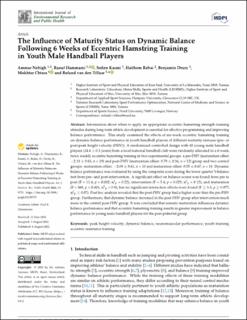| dc.contributor.author | Nebigh, Ammar | |
| dc.contributor.author | Hammami, Raouf | |
| dc.contributor.author | Kasmi, Sofien | |
| dc.contributor.author | Rebai, Haithem | |
| dc.contributor.author | Drury, Benjamin | |
| dc.contributor.author | Chtara, Mokhtar | |
| dc.contributor.author | van den Tillaar, Roland Johannes Wilhelmus | |
| dc.date.accessioned | 2023-02-13T13:49:52Z | |
| dc.date.available | 2023-02-13T13:49:52Z | |
| dc.date.created | 2022-10-04T13:44:56Z | |
| dc.date.issued | 2022 | |
| dc.identifier.citation | Nebigh, A., Hammami, R., Kasmi, S., Rebai, H., Drury, B., Chtara, M. & van den Tillaar, R. (2022). The influence of maturity status on dynamic balance following 6 weeks of eccentric hamstring training in youth male handball players. International Journal of Environmental Research and Public Health, 19(15), Article 9775. doi: | en_US |
| dc.identifier.issn | 1660-4601 | |
| dc.identifier.uri | https://hdl.handle.net/11250/3050459 | |
| dc.description.abstract | Information about when to apply an appropriate eccentric hamstring strength training stimulus during long-term athlete development is essential for effective programming and improving balance performance. This study examined the effects of six-week eccentric hamstring training on dynamic balance performance in youth handball players of different maturity statuses (pre- or post-peak height velocity (PHV)). A randomized controlled design with 45 young male handball players (14.6 ± 0.3 years) from a local national handball club were randomly allocated to a 6 week, twice weekly eccentric hamstring training in two experimental groups: a pre-PHV (maturation offset: −2.13 ± 0.63, n = 10) and post-PHV (maturation offset: 0.79 ± 0.34, n = 12) group and two control groups: maturation offset: −2.09 ± 0.61, n = 10 and maturation offset: 0.55 ± 0.67, n = 13. Dynamic balance performance was evaluated by using the composite score during the lower quarter Y-balance test from pre- and post-intervention. A significant effect on balance scores was found from pre to post (F = 11.4; p = 0.002; η2p = 0.22), intervention (F = 5.4; p = 0.025; η2p = 0.12), and maturation (F = 369; p < 0.001; η2p = 0.9), but no significant interaction effects were found (F ≥ 3.3; p ≥ 0.077; η2p ≤ 0.07). Post hoc analysis revealed that the post-PHV group had a higher score than the pre-PHV group. Furthermore, that dynamic balance increased in the post-PHV group after intervention much more in the control post-PHV group. It was concluded that somatic maturation influences dynamic balance performance and that eccentric hamstring training results in greater improvement in balance performance in young male handball players for the post-pubertal group. | en_US |
| dc.language.iso | eng | en_US |
| dc.publisher | MDPI | en_US |
| dc.rights | Navngivelse 4.0 Internasjonal | * |
| dc.rights.uri | http://creativecommons.org/licenses/by/4.0/deed.no | * |
| dc.title | The influence of maturity status on dynamic balance following 6 weeks of eccentric hamstring training in youth male handball players | en_US |
| dc.type | Peer reviewed | en_US |
| dc.type | Journal article | en_US |
| dc.description.version | publishedVersion | en_US |
| dc.rights.holder | © 2022 The Authors | en_US |
| dc.source.pagenumber | 9 | en_US |
| dc.source.volume | 19 | en_US |
| dc.source.journal | International Journal of Environmental Research and Public Health (IJERPH) | en_US |
| dc.source.issue | 15 | en_US |
| dc.identifier.doi | 10.3390/ijerph19159775 | |
| dc.identifier.cristin | 2058422 | |
| dc.source.articlenumber | 9775 | en_US |

